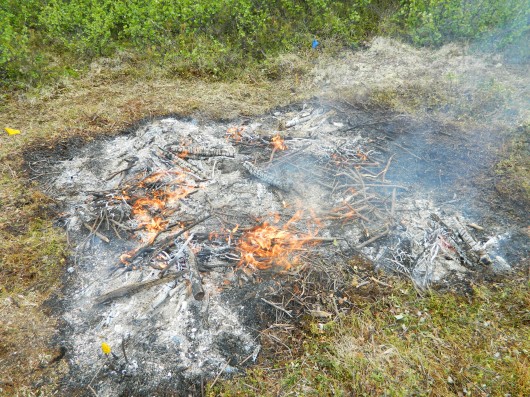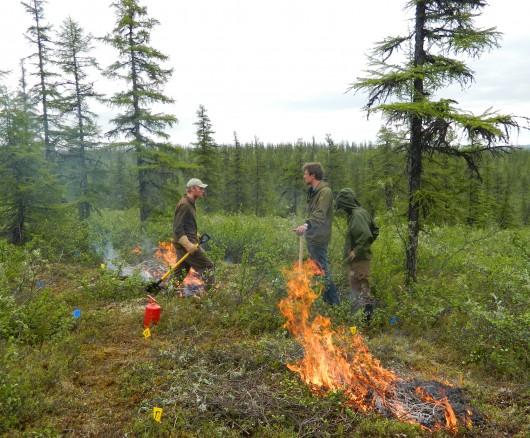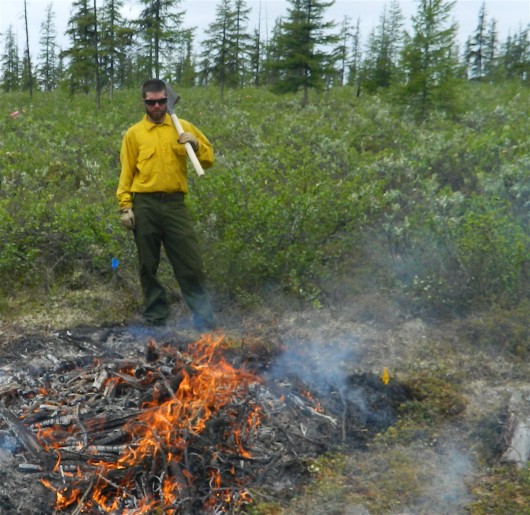Burn day. Our anticipation has been fueled (literally) by expectations, curiosities, and uncertainties of conducting experimental burns here at the Northeast Science Station. Our long-term goal for this project has stemmed from nearly a year of preparation and planning. In previous years, crews have noted vast variations in density of the Larch forest, ranging from stands with sparse trees in a savanna like system, to the very dense so called ‘bamboo’ forest stands. When forest fires burn the organic layer of soil, consisting of mosses, decaying plant material and roots, this provides the seedbed on which new Larch seeds must regenerate. The depth of the burn affects greatly whether the seedlings will be successful, or simply dry out in the remaining organic layer, which tends to experience extremes of temperature and moisture compared to mineral soil. This variation in both forest stand density and known variation in burn severity (amount of organic material consumed by the fire), framed the impetus for our experimental burns. By seeding Larch on the burned plots, we hope to examine the effects of varying burn severity on larch regeneration. Variations in larch regeneration have a very significant impact on aboveground and belowground carbon pools following fires. Forest fires are the major disturbance in the circumpolar Boreal forest, and better understanding their dynamics under the influence of global climate change is a key step in a positive direction.

While the burning of our experimental plots only took the better part of a day, the preparation for burning amounted to a colossal amount of work and critical decisions. Due to the logistical challenges involved in working in Siberia, we decided to take a natural approach to achieving burns of differing severity: fuel loading. Over the last 5 days we have spent countless hours collecting woody fuels of various sizes to add to our plots in order to consume the organic layer. Knowing how much fuel, in the form of biomass, is added to our plots is crucial. We thus collected, dried, and weighed set amounts of fuels to add to our plots. Size classes ranged from fine twigs and leaves to coarse logs, and everything in between. By our calculations, over 450kg (1000lb) of wood was added to our 12 burn plots. The plots were a manageable 2m X 2m, and consisted of replicates of low, medium, and high fire severity. It’s humbling and a bit unnerving to see your countless hours of work burned away in a few hours. A few very fun hours! The night before we all went to sleep hoping all would go well – and the rain would stay away.

After breakfast we headed to the burn plots and began loading our carefully dried and weighed fuels to the plots, grading from fine twigs and leaves to large logs. With a decent southerly breeze helping us along, the plots burned smoothly. The various fuel loads seemed to be burning hotter, deeper, and longer depending on intensity – just as planned. We managed to keep logs and coals moving around to keep up even consumption of the organic layer. With a lot of thanks to Nikita, who has “burned in Siberia all his life”, we accomplished our goals, and then some. A lot of the time was spent organizing fuels to load, watching for spot fires and creeping hotspots. In the end we spent part of a second day re-burning our high severity plots to get some divergence in treatment effect from the moderate plots.

Post burn measurements are also very important. Measurement of residual organic depth showed a high correlation with treatment, a good sign. Now we will continue to monitor the active layer depth of the permafrost, burn effects on soils, and enjoy continuous long-term soil temperature monitoring in all the plots.
Many of the ecological effects of fire, aside from the obvious, are not immediate. Often, increased soil moisture results after fires with few plants taking up and transpiring water. Surface albedo (the reflectance of the earth surface) in burned areas is also altered, gaining a lot more absorbed solar energy. These are just a few of the most visible and immediate effects of fires. With time and attentive measurements, we hope to understand how a change like burn severity can affect the entire trajectory of the Larch forest ecosystem, and climate change’s ever increasing effects on fluxes and storage of carbon.




Comments(2)-
-
Joanne Heslop says
July 9, 2012 at 6:44 pmThat is so exciting! I cannot believe you guys have the opportunity to do that this year. Are you also monitoring how the burns alter nutrient cycling? It would be cool to look at soil C respiration from the different burn plots.
Chris Ganzlin says
July 9, 2012 at 7:50 pmThank you for writing about the burns. It helps us to unerstand this important work and research- and to know all is going well!